Gout is a kind of arthritis that occurs when uric acid builds up in blood and causes joint inflammation.
- Acute gout is a painful condition that typically affects one joint.
- Chronic gout is repeated episodes of pain and inflammation, which may involve more than one joint.
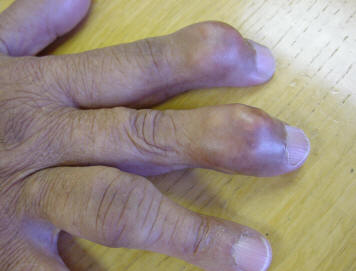 |
| neglected chronic gout with tophi. |
 |
| chronic gout in hands. |
 |
| Chronic joint involvement with crystal accumulation - tophus |
Causes, incidence, and risk factors
 |
| accumulation of uric acid in joints. |
- Your body makes too much uric acid
- Your body has a hard time getting rid of uric acid
If too much uric acid builds up in the fluid around the joints (synovial fluid), uric acid crystals form. These crystals cause the joint to swell up and become inflamed.
The exact cause is unknown. Gout may run in families. It is more common in men, in women after menopause, and those who drink alcohol. People who take certain medicines, such as hydrochlorothiazide and other water pills, may have higher levels of uric acid in the blood.
The condition may also develop in people with:
- Diabetes
- Obesity
- Sickle cell anemia and other anemias
- Leukemia and other blood cancers
Symptoms of acute gout:
- Symptoms usually involve only one or a few joints. The big toe, knee, or ankle joints are most often affected.
- The pain starts suddenly, often during the night and is often described as throbbing, crushing, or excruciating.
- The joint appears warm and red. It is usually very tender (it hurts to lay a sheet or blanket over it).
- There may be a fever.
- The attack may go away in a few days, but may return from time to time. Additional attacks often last longer.
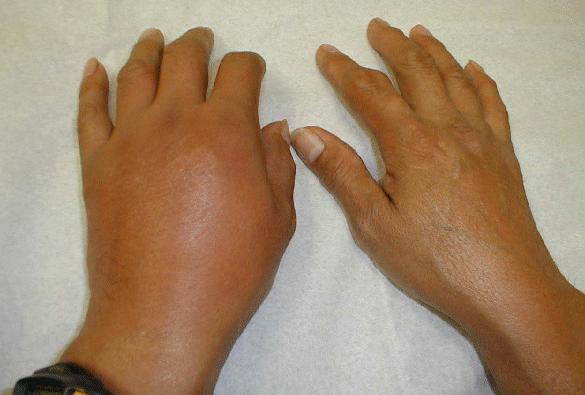 |
| swelling in early gout. |
 |
| in early phase gout swelling occurs of the soft tissue. |
After a first gouty attack, people will have no symptoms. Half of patients have another attack.
Some people may develop chronic gout. Those with chronic arthritis develop joint damage and loss of motion in the joints. They will have joint pain and other symptoms most of the time.
Tophi are lumps below the skin around joints or in other places. They may drain chalky material. Tophi usually develop only after a patient has had the disease for many years.
Acute Gout
Colchicine and Nonsteroidal anti-inflammatory drugs (NSAIDs) are effective in the treatment of acute gout and are much superior to paracetamol or aspirin. In addition, NSAIDs are superior to colchicine in terms of speed of onset of action. Thus, despite having been used for centuries, colchicine is usually reserved for patients in whom NSAIDs are contraindicated. Oral corticosteroids such as prednisone is useful in resistant gout and we use this for 10 days to 2 weeks, during and after treatment of the acute episode, whilst instituting second line therapy to prevent recurrence in patients who are difficult to control.
Intra-articular administration of Corticosteroids is a particularly effective means of terminating an attack of gout.
Resolution is typically complete within 12–24 hours.
Cortisone is of particular value in some patients with renal impairment and other conditions where the use of full doses of other drugs may be relatively contraindicated.
The principle of treatment of tophi is to lower the plasma urate concentration to such a degree, as to allow urate to be resorbed from the surface of the tophi. The uric acid therefore is slowly excreted at the kidney, and production is lower than excretion, resulting in net loss of uric acid.
(In this phase, I use citrosoda 10ml twice a day to prevent deposition of crystal in the kidney, and prevent kidney stone developement.)
It is therefore aimed at maintaining the urate concentration within the middle of the optimal range.
This requires the long-term use of urate-lowering drugs over many years.
Colchicine and most NSAIDs, while controlling acute attacks, will not prevent the formation of tophi and may, by preventing the inflammatory response, actually increase the development of tophi unless hyperuricemia is controlled at the same time.
Gout and diet
Acute Gout
Colchicine and Nonsteroidal anti-inflammatory drugs (NSAIDs) are effective in the treatment of acute gout and are much superior to paracetamol or aspirin. In addition, NSAIDs are superior to colchicine in terms of speed of onset of action. Thus, despite having been used for centuries, colchicine is usually reserved for patients in whom NSAIDs are contraindicated. Oral corticosteroids such as prednisone is useful in resistant gout and we use this for 10 days to 2 weeks, during and after treatment of the acute episode, whilst instituting second line therapy to prevent recurrence in patients who are difficult to control.
Intra-articular administration of Corticosteroids is a particularly effective means of terminating an attack of gout.
Resolution is typically complete within 12–24 hours.
Cortisone is of particular value in some patients with renal impairment and other conditions where the use of full doses of other drugs may be relatively contraindicated.
 |
| acute gout. |
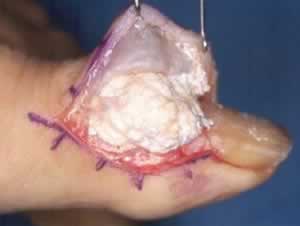 |
| surgical removal of balls of uric acid in acute gout. Tophaceous Gout |
 |
| tophaceous gout normally develops in 10 yrs of acute gout. |
(In this phase, I use citrosoda 10ml twice a day to prevent deposition of crystal in the kidney, and prevent kidney stone developement.)
It is therefore aimed at maintaining the urate concentration within the middle of the optimal range.
This requires the long-term use of urate-lowering drugs over many years.
Colchicine and most NSAIDs, while controlling acute attacks, will not prevent the formation of tophi and may, by preventing the inflammatory response, actually increase the development of tophi unless hyperuricemia is controlled at the same time.
Gout and diet
Signs and tests
Tests that may be done include:
- Synovial fluid analysis (shows uric acid crystals)
- Uric acid - blood
- Joint x-rays (may be normal)
- Synovial biopsy
- Uric acid - urine
Not everyone with high uric acid levels in the blood has gout.
Treatment
Medicines should be taken as soon as possible if you have a sudden gout attack.
- Take nonsteroidal anti-inflammatory drugs (NSAIDs) such as ibuprofen, naproxen, or indomethacin as soon as your symptoms begin. Talk to your health care provider about the correct dose. You will need stronger doses for a few days.
- Your health care provider may prescribe strong painkillers such as codeine, hydrocodone, and oxycodone.
- A prescription medicine called colchicine helps reduce pain, swelling, and inflammation.
- Corticosteroids can also be very effective. Your doctor may inject the inflamed joint with steroids to relieve the pain.
- The pain often goes away within 12 hours of starting treatment, and is completely relieved in 48 hours.
Daily use of allopurinol or probenecid decrease uric acid levels in your blood. Your doctor may prescribe these medicines if:
- You have several attacks during the same year or your attacks are quite severe
- You have damage to joints
- You have tophi
- You have uric acid kidney stones
Some diet and lifestyle changes may help prevent gouty attacks:
- Avoid alcohol
- Limit how much meat you eat at each meal.
- Avoid fatty foods such as salad dressings, ice cream, and fried foods.
- Eat enough carbohydrates.
- If you are losing weight, lose it slowly. Quick weight loss may cause uric acid kidney stones to form.
Complications
Prevention
The disorder itself may not be preventable, but you may be able to avoid things that trigger your symptoms. Limit alcohol consumption and follow a low-purine diet.

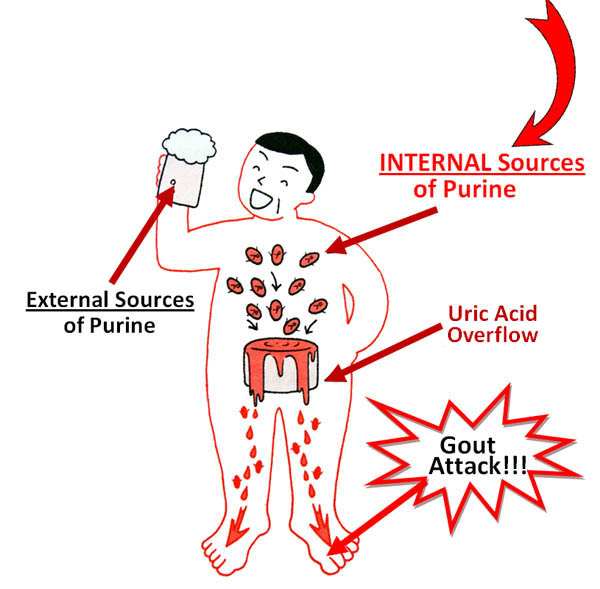



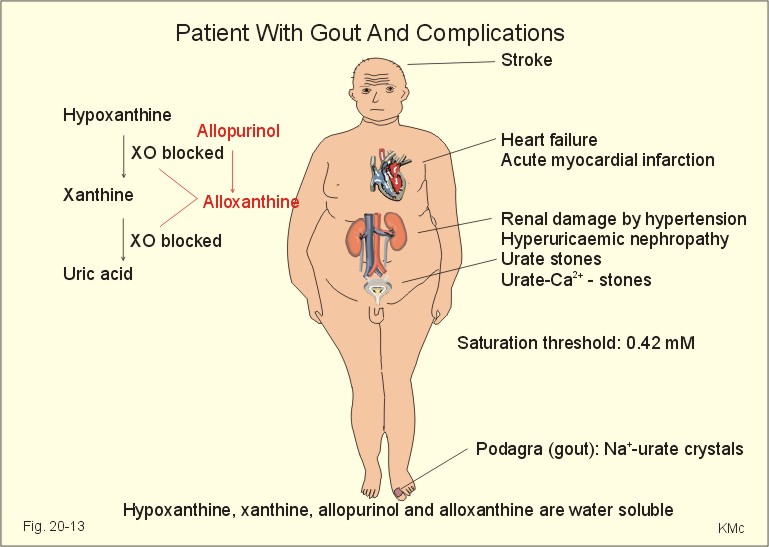
No comments:
Post a Comment